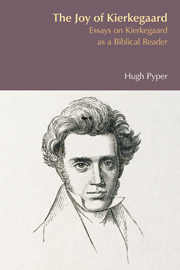Book contents
- Frontmatter
- Contents
- Preface
- Acknowledgments
- Abbreviations
- 1 The Joy of Kierkegaard
- 2 Kierkegaard's Canon: The Constitution of the Bible and of the Authorship in Concluding Unscientific Postscript
- 3 The Apostle, the Genius and the Monkey: Reflections on Kierkegaard's ‘The Mirror of the Word’
- 4 Your Wish Is My Command: The Peril and Promise of the Bible as ‘Letter from the Beloved’
- 5 The Lesson of Eternity: The Figure of the Teacher in Kierkegaard's Philosophical Fragments
- 6 Cities of the Dead: The Relation of Person and Polis in Kierkegaard's Works of Love
- 7 Adam's Angest: The Language of Myth and the Myth of Language
- 8 Beyond a Joke: Kierkegaard's Concluding Unscientific Postscript as a Comic Book
- 9 ‘Sarah Is the Hero’: Kierkegaard's Reading of Tobit in Fear and Trembling
- 10 How Edifying Is Upbuilding? Paul and Kierkegaard in Dialogue
- 11 Forgiving the Unforgivable: Kierkegaard, Derrida and the Scandal of Forgiveness
- Bibliography
- Index of Biblical References
- Index of Authors
9 - ‘Sarah Is the Hero’: Kierkegaard's Reading of Tobit in Fear and Trembling
- Frontmatter
- Contents
- Preface
- Acknowledgments
- Abbreviations
- 1 The Joy of Kierkegaard
- 2 Kierkegaard's Canon: The Constitution of the Bible and of the Authorship in Concluding Unscientific Postscript
- 3 The Apostle, the Genius and the Monkey: Reflections on Kierkegaard's ‘The Mirror of the Word’
- 4 Your Wish Is My Command: The Peril and Promise of the Bible as ‘Letter from the Beloved’
- 5 The Lesson of Eternity: The Figure of the Teacher in Kierkegaard's Philosophical Fragments
- 6 Cities of the Dead: The Relation of Person and Polis in Kierkegaard's Works of Love
- 7 Adam's Angest: The Language of Myth and the Myth of Language
- 8 Beyond a Joke: Kierkegaard's Concluding Unscientific Postscript as a Comic Book
- 9 ‘Sarah Is the Hero’: Kierkegaard's Reading of Tobit in Fear and Trembling
- 10 How Edifying Is Upbuilding? Paul and Kierkegaard in Dialogue
- 11 Forgiving the Unforgivable: Kierkegaard, Derrida and the Scandal of Forgiveness
- Bibliography
- Index of Biblical References
- Index of Authors
Summary
‘Perhaps the most extreme misreading of the book of Tobit is Søren Kierkegaard's deliberately “imaginary” reading.’ So claims David McCracken in his stimulating article ‘Narration and Comedy in the Book of Tobit.’ Such a remark throws down a challenge which is hard to resist. It would be fascinating, if unfair, to take this as an incentive to trawl the literature for more extreme misreadings. In any case, to pinpoint definitively the ‘most extreme’ would require us to subject the notion of misreading to more scrutiny that it could perhaps bear. We can more profitably ask what leads McCracken to read Kierkegaard this way and how such disagreements over what constitutes a misreading may illuminate our reading of Tobit.
As the title of his paper indicates, McCracken reads Tobit as a comedy. By contrast, Kierkegaard, or, more accurately, his pseudonym Johannes de Silentio, devotes four pages of Fear and Trembling, his astonishing attempt to work out the consequences of Abraham's sacrifice of Isaac, to a discussion of the plight of Sarah and writes, ‘I have read about many griefs, but I doubt that there is to be found a grief as profound as the one in this girl's life’ (FT, 102). It is de Silentio's insistence that Sarah is a tragic figure that seems to be at the root of McCracken's accusation of misreading. ‘No reader is likely to be in tears,’ claims McCracken, while reading Sarah's story.
- Type
- Chapter
- Information
- The Joy of KierkegaardEssays on Kierkegaard as a Biblical Reader, pp. 115 - 129Publisher: Acumen PublishingPrint publication year: 2012



